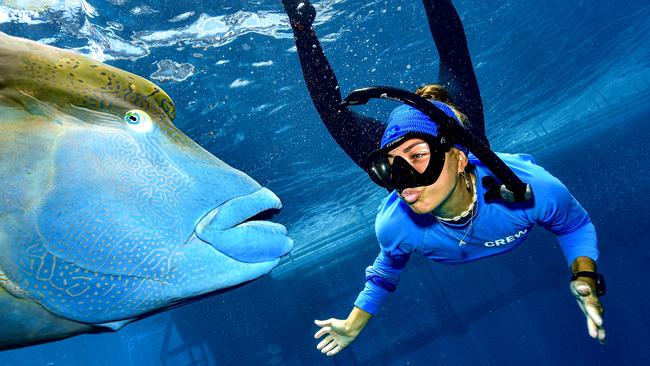‘An underwater rainbow’: Marine biologist details amazing underwater encounters
Marine biologist Natalie Smith never gets tired of witnessing the joy and amazement on people's faces the first time they experience the Great Barrier Reef.

QWeekend
Don't miss out on the headlines from QWeekend. Followed categories will be added to My News.
‘It’s like an underwater rainbow out there.”
That’s Natalie Smith, a marine biologist, describing perhaps the most magnificent workplace on the entire planet – the Great Barrier Reef. As part of her role with Experience Co and GBR Biology, Smith, 29, takes visitors on guided snorkel tours into the depths of one of the seven natural wonders of the world.
“It’s abundant with life and there’s a beautiful diversity of marine creatures and lots of colours, from the turquoise blues of our beautiful parrotfish to those bright yellows of our butterflyfish and rabbitfish, and then the beautiful colours of our corals.

“As soon as you immerse yourself in the water you hear the reef as well. At the moment you can hear the little chitters and chatters of the fish and the whales singing and vocalising, which is absolutely amazing,” she says.
Fun facts about the Great Barrier Reef roll off Smith’s tongue.
It’s the world's largest coral reef system, can be seen from outer space, is 2600km long, it’s made up of about 3000 individual reefs, and it reaches an area of over 345,000sq m – about the same size as Italy or Japan.
Smith’s love for the ocean began at a young age. Growing up in the New South Wales coastal town of Port Macquarie, between Brisbane and Sydney, most weekends were spent at the beach where her dad would often take her snorkelling in the intertidal rock pools.
“I’d be hanging on the back of dad’s back while he was snorkelling and then that led to me starting to snorkel as well. I remember seeing whiting and bream and quite large wobbegong sharks with him and lots of little snails and starfish. I definitely got my love of the ocean from my dad and being interested in all the beautiful creatures that live within it,” she says.

At high school, Smith got involved in marine studies and continued on to a Bachelor of Marine Science and Management at Southern Cross University. While completing her degree she got a job working on whale watching vessels, only deepening her love for the ocean and its awe-inspiring inhabitants.
“It doesn’t matter how many times I see a whale, it still brings the biggest smile to my face. It’s a feeling that’s hard to describe,” Smith says.
On a trip to visit her aunt and cousins in Port Douglas in 2014, Smith went out to the Great Barrier Reef for the very first time. She was smitten.
“I pretty much fell in love with the reef from a dive and snorkel tour that I went on. I swore that after I graduated I would make the move up to Cairns to pursue a career on the Great Barrier Reef,” she says.
Her plan came to fruition in 2022 when she got her current job with GBR Biology. As well as doing guided snorkel tours where green sea turtles and clownfish make regular appearances (“Nemo is always super popular”), Smith is involved in research and training.
“We’re pretty fortunate on our pontoon where we have a full working wet lab and research quarters. We get a lot of different researchers and PhD students and people from places like CSIRO come out and stay, so you get to be involved with projects that they’re working on too. We also do site stewardship which involves things like data collection, surveys, monitoring and crown-of-thorns starfish control,” she says.

For the uninitiated, crown-of-thorns starfish are a native coral predator on the Great Barrier Reef which can cause havoc when their numbers get too large. For Smith, sharing her knowledge of the world heritage site with visitors and helping to protect it is the most rewarding part of the job.
“Being able to educate people on what it is they’re seeing, what it does, what its role is in the ecosystem and why it’s worth protecting helps them build a stronger connection with the reef. And if you’re connected to something, you want to be able to save it,” she says.
“With climate change, they’re predicting some of the disturbances we get to the reef like tropical cyclones and bleaching will become more frequent and more severe, so we need to be doing our part at home to bring down our carbon emissions… just being more conscious of recycling or turning that light switch off at home that doesn’t need to be on. If we can get every guest to start thinking about that, then hopefully we’re going to have a nice impact.”
Last year, Smith became a Master Reef Guide through a program delivered by the Great Barrier Reef Marine Park Authority, Association of Marine Park Tourism Operators and Tourism and Events Queensland. It’s the highest honour in the guiding field and one Smith is proud to have attained.

“My favourite part of the job is witnessing firsthand the joy and amazement on guests’ faces when they see the Great Barrier Reef for the first time because I still get that every time,” she says.


